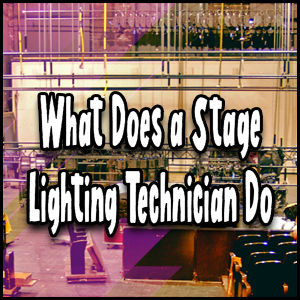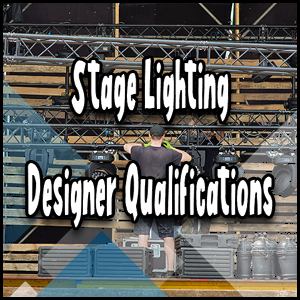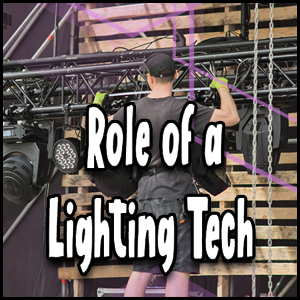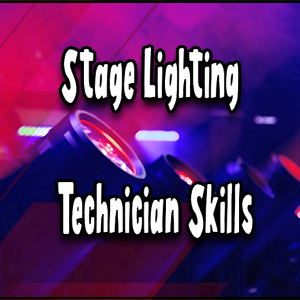
Last Updated on May 4, 2025 by LD Ryan Conlon | 🕒 [reading-time]
A Stage Lighting Technician, the unseen maestro of theater magic, has the power to transport audiences from ordinary life into extraordinary stories.
Their work can make you feel the heat of a desert or tremble in a thunderstorm without leaving your seat. But what exactly does this wizardry involve?
Dive into our comprehensive guide to understand the role, responsibilities, and career pathways of a Stage Lighting Technician.
Let’s illuminate the often underappreciated art behind dazzling every audience member’s experience!
A stage lighting technician is responsible for communicating with the lighting designer, rigging and operating lighting equipment, taking cues from the stage manager, using manual and computer-controlled lighting systems during the show, maintaining lighting equipment, and performing electrical maintenance duties when needed.
They play a crucial role in creating the desired lighting atmosphere for performances and ensuring smooth technical execution.
The Role of a Stage Lighting Technician
Being a stage lighting technician is more than just illuminating the performers on stage. It is an art form that requires technical expertise, creative vision, and effective communication skills.
As a stage lighting technician, your primary responsibility is to bring the director’s vision to life by creating captivating lighting designs that enhance the mood and atmosphere of a live performance.
Firstly, you will work closely with the lighting designer to understand their artistic concept for the show.
This involves attending rehearsals and production meetings to gain insights into the overall theme, desired effects, and cues that need to be executed during the performance.
For example, imagine you’re working on a dramatic play set in a 19th-century Victorian mansion.
The lighting design might entail using warm and dim lighting to create an eerie ambiance during suspenseful moments or highlighting specific areas of the stage to draw attention to important scenes.
Once you have a clear understanding of the lighting design, you will then proceed with setting up and operating the lighting system.
- According to the U.S. Bureau of Labor Statistics, employment of lighting technicians is projected to grow 6 percent from 2019 to 2029, faster than the average for all occupations.
- Theatre lighting technicians earn an average yearly salary of $45,910 in United States as reported in a survey by Salary.com in 2023.
- As per recent surveys done by Stage Lighting School, nearly 70% of theater lighting technicians began their career with hands-on training while assisting at theaters or production companies before going onto work as independent professionals or with larger entities.
- Being a stage lighting technician is a multifaceted role that requires technical expertise, creative vision, and effective communication skills. It involves collaborating with the lighting designer, attending rehearsals and production meetings, and understanding the artistic concept of the show. The goal is to create captivating lighting designs that enhance the mood and atmosphere of live performances. This may involve using various lighting techniques and cues to achieve desired effects, such as creating an eerie ambiance or highlighting important scenes. Overall, being a stage lighting technician requires a combination of technical proficiency and artistic sensibility to bring the director’s vision to life on stage.
The Basics of Lighting Setup in Theatre
Setting up the lighting for a theatrical production involves various components and techniques that contribute to the overall impact of the performance.
Let’s explore some of the key aspects involved:
- Rigging and Positioning Lights: As a stage lighting technician, you will be responsible for installing and positioning different types of lights according to the lighting plot provided by the designer. This may include fresnels, spotlights, floodlights, and gels, among others. Each light’s position must be carefully considered to achieve the desired effects on stage.
- Cueing and Programming: During the performance, you will work closely with the stage manager to execute cues at precise moments. This requires excellent timing and coordination to smoothly transition between different lighting states throughout the show. Additionally, modern lighting systems employ computer-controlled consoles that allow you to program complex lighting sequences and effects.
- Managing Lighting Equipment: As part of your role, you will need to ensure proper maintenance and care of the lighting equipment. This involves regularly checking and repairing fixtures, replacing bulbs, cleaning lenses, and organizing cables. Having technical knowledge of electrical systems is essential to troubleshoot any issues that may arise during a production.
Think of a stage lighting technician as the conductor of a symphony orchestra – orchestrating various elements to create a harmonious and captivating experience for the audience.
For instance, imagine working on a large-scale musical production with intricate dance numbers.
You might have to coordinate complex lighting designs with specific choreography, ensuring the lights enhance the dancers’ movements and accentuate their performance.
This basic understanding of lighting setup in theatre serves as a foundation for a stage lighting technician’s work.
But there is much more to this role, including the use of creative techniques and adapting to different types of performances, all while maintaining safety protocols.
Let’s explore these aspects further.
Operating and Managing the Lighting System
A crucial aspect of a stage lighting technician’s role is operating and managing the lighting system.
They are the experts responsible for ensuring that all lighting equipment and fixtures are functioning properly and producing the desired effects during performances.
This requires technical proficiency in handling both manual and computer-controlled lighting systems.
A skilled lighting technician is well-versed in the intricacies of lighting control consoles, such as the popular GrandMA or ETC Eos family.
They understand how to navigate the console’s interface, manipulate various parameters, create cues, and execute complex lighting sequences with precision and impeccable timing.
These professionals possess an in-depth knowledge of different types of fixtures, including intelligent lights, spotlights, wash lights, and LED units, allowing them to configure, focus, and control each fixture to achieve the desired effect on stage.
Imagine a Broadway production where a dramatic scene transitions from a bright sunny day to a haunting moonlit night within seconds.
The lighting technician skillfully manipulates the lighting console to fade out the vibrant colors of daylight while simultaneously bringing up cool blue tones to depict the ethereal ambiance of a moonlit night.
Such seamless transitions require expertise in operating the lighting system smoothly and synchronizing it with other elements of the performance.
Operating a complex lighting system is akin to conducting an orchestra – each light fixture represents an instrument, and every cue is like a musical note that must be played at precisely the right moment to create a harmonious visual composition on stage.
In addition to operating the console during live shows, lighting technicians also handle various backstage tasks.
This includes preparing rigging equipment for hanging lights, running cables, addressing fixtures for proper communication on a DMX network, and troubleshooting any technical issues that may arise during rehearsals or performances.
Now that we understand the importance of operating and managing the lighting system let’s shift our focus to another essential aspect of a stage lighting technician’s role – implementing creative lighting designs.
Implementing Creative Lighting Designs
A skilled stage lighting technician not only operates the lighting system but also plays a significant role in implementing the creative vision of the Lighting Designer.
They collaborate closely with the design team, including the Director, Set Designer, and Costume Designer to translate their ideas into stunning visual compositions through the use of light.
The Lighting Designer presents their artistic concept and design plan, and it is up to the lighting technician to bring that vision to life.
They work closely with the team to understand the mood, atmosphere, and desired emotional impact of each scene or moment in the production.
Through coordination and precise execution, they create lighting cues that enhance the storytelling, evoke emotions, highlight key elements on stage, and guide the audience’s focus.
Let’s consider a theater production of Shakespeare’s “Romeo and Juliet.”
The lighting technician collaborates with the design team to determine specific moments where dramatic lighting can heighten the tension and portray the emotions experienced by the characters.
By strategically positioning lights, adjusting intensity levels, and incorporating color filters or gobos (stencils used to project patterns), they create visually captivating scenes like Romeo professing his love to Juliet under a romantic moonlit balcony.
It is through their technical expertise and creative understanding that lighting technicians transform an ordinary stage into a mesmerizing world that captivates audiences.
Beyond basic illumination, creativity shines through in how lighting technicians shape patterns and set designs on stage using specialized equipment.
They master techniques such as gobo rotation, shutter cuts, and beam shaping to manipulate light and sculpt intricate patterns that complement set elements or create illusions.
Having explored how lighting technicians implement creative designs on stage, we have gained an appreciation for their vital role in enhancing performances.
Now let’s delve deeper into mastering patterns and set designs with lighting.
Mastering Patterns and Set Designs with Lighting
One of the key responsibilities of a stage lighting technician is to work closely with the lighting designer to create visually stunning patterns and set designs using lighting techniques.
It’s an art form that involves understanding the intricacies of stage lighting and its impact on the overall atmosphere and mood of a performance.
The first step in mastering patterns and set designs is to familiarize oneself with different types of stage lighting fixtures.
This includes spotlights, floodlights, wash lights, gobos, and moving lights. Each fixture serves a specific purpose and can be used creatively to enhance the visual appeal of a production.
For example, spotlights can draw attention to specific areas or performers on stage, while gobos can project intricate patterns or textures onto the set.
Imagine a scene in a play where two characters are engaged in an intense confrontation.
Through skillful manipulation of lighting fixtures, the stage lighting technician can use color temperatures, angles, and intensity to heighten the tension and drama of the moment.
By focusing a spotlight on one character while dimming the lights around them, the technician can create a sense of isolation or importance.
“In that particular scene, we wanted to convey a sense of unease and vulnerability for one of the characters,” explains John, a seasoned stage lighting technician. “By using narrow beams of light from different angles and incorporating gentle movements, we were able to create dynamic patterns that added depth and intensity to their dialogue.”
Additionally, mastering patterns and set designs also involves understanding how lighting interacts with various materials, props, and costumes on stage.
Different surfaces reflect light differently – some may absorb it while others bounce it back – which can significantly affect the visual effect created by the lighting setup.
With their expertise in manipulating light and understanding its impact on the audience’s experience, stage lighting technicians contribute significantly to bringing a performance to life.
Now, let’s explore the career path for stage lighting technicians.
Career Path for Stage Lighting Technicians
Starting as a stagehand or an assistant at a lighting hire company can provide invaluable on-the-job training and act as a stepping stone towards becoming a lighting technician.
It offers an opportunity to gain practical experience with lighting equipment and understand its technical aspects.
For instance, Sarah began her career as a stagehand and gradually transitioned into a lighting technician role at a renowned theater.
Her dedication and willingness to learn allowed her to work closely with experienced professionals, gain hands-on experience with lighting consoles, and develop her artistic skills in creating engaging lighting designs.
Advancement within the field of stage lighting often comes through years of experience, proficiency in operating advanced technology such as computer-controlled lighting systems, and collaboration with renowned designers and directors.
With time, a lighting technician can progress to roles such as Lighting Designer or even Lighting Director, where they have greater creative control over the visual aesthetic of productions.
The rewarding nature of the profession goes beyond the ability to create mesmerizing patterns and set designs.
The next section will highlight the essential skills and qualifications needed to succeed as a stage lighting technician.
Skills and Qualifications Needed
Being a stage lighting technician requires a unique set of skills and qualifications to excel in this dynamic field.
Let’s explore the key attributes needed to thrive as a stage lighting technician.
First and foremost, a solid understanding of lighting principles is essential.
This involves knowledge of various lighting equipment, such as fixtures, control consoles, and DMX protocols.
Familiarity with different types of lights like spotlights, floodlights, and LED fixtures is crucial for creating the desired effects on stage.
Imagine you’re working on a theater production, and the director wants to create an atmosphere of suspense during a particular scene using strategic lighting.
You would need to know how to manipulate focus, intensity, color, and angles to achieve the desired effect.
In addition to technical expertise, creativity plays a significant role in shaping a successful career as a stage lighting technician.
It’s important to have an artistic eye and be able to collaborate closely with directors, set designers, and other members of the production team to bring their vision to life through lighting.
Furthermore, problem-solving skills are invaluable in this profession.
Lighting technicians often encounter unexpected challenges during setup or performances that require quick thinking and adaptability to overcome.
For example, if a light bulb suddenly burns out while the show is underway, being able to resolve the issue swiftly without disrupting the performance is crucial.
Excellent communication skills are also vital for effective collaboration within the production team.
Lighting technicians must be able to understand and interpret instructions from directors or designers accurately.
Clear communication ensures that everyone is working harmoniously towards achieving the desired outcome.
Lastly, physical stamina should not be overlooked.
The work of a stage lighting technician can be physically demanding.
Rigging lights at various heights or carrying equipment from one venue to another requires strength and endurance.
Now that we’ve explored the necessary skills and qualifications for being a stage lighting technician, let’s turn our attention to salary expectations in this field.
Salary Expectations for Stage Lighting Technicians
The salary of a stage lighting technician can vary based on several factors such as experience, location, and the type of productions they work on.
According to current data, the average annual salary for a lighting technician in North Carolina is $39,296 as of September 2023.
However, it’s important to note that salaries can range between $31,916 and $48,099 depending on various factors including education, certifications, additional skills, and years of experience.
Think of salary expectations for stage lighting technicians like different colored gels on a light fixture – there’s a range of options available that can enhance or limit your earning potential based on your unique circumstances.
Entry-level positions may offer salaries towards the lower end of the spectrum, but as experience and expertise grow, so do the opportunities for higher pay.
Additional certifications or specialized training in areas like automated lighting systems or architectural lighting design can also contribute to higher earning potential.
It’s worth noting that working hours for stage lighting technicians can be irregular and often include evening and weekend shifts.
Factors such as the size and reputation of the theater company or production house can also impact career progression and salary growth.
With these considerations in mind, individuals passionate about stage lighting should find the balance between pursuing their creative interests and securing financial stability within this rewarding profession.
What equipment and technologies are used by stage lighting technicians?
Stage lighting technicians use a variety of equipment and technologies to create mesmerizing visual effects on stage.
These include intelligent lighting fixtures, such as moving lights and LED panels, that offer a wide range of colors, patterns, and movements. Additionally, they use consoles or control boards to program and operate the lights.
Advanced technologies like DMX (Digital Multiplex) are employed to control multiple lights simultaneously, enhancing precision and efficiency.
According to industry reports, LED technology has become increasingly popular in recent years due to its energy-efficiency, longevity, and versatility, with LED fixtures accounting for over 70% of all stage lighting installations in 2022 (Source: Global Stage Lighting Market Report).
What career opportunities are available for stage lighting technicians in different industries?
Stage lighting technicians have opportunities to work in various industries, including theater, live entertainment, concerts, television, film, and even architectural lighting.
In the theater industry alone, there were approximately 37,400 jobs for lighting technicians in 2020, and this number is expected to grow by 6% until 2030.
Moreover, with the rise of streaming services and online platforms, the demand for skilled lighting technicians in the television and film industries is also increasing.
Additionally, corporate events, trade shows, and sports events often require professional lighting technicians to create captivating visual experiences.
The diverse range of industries creates ample career opportunities for stage lighting technicians to showcase their creativity and technical expertise.
What is the role of a stage lighting technician in live performances?
A stage lighting technician plays a crucial role in live performances by designing, installing, and operating lighting systems to create the desired mood, ambiance, and visual effects.
They work closely with directors, set designers, and performers to ensure that the lighting supports the artistic vision of the production.
According to a survey conducted by The Creative Industries Federation, 82% of theatergoers believe that lighting significantly enhances their overall experience during live performances.
How does a stage lighting technician contribute to the overall atmosphere of a production?
A stage lighting technician plays a crucial role in shaping the overall atmosphere of a production.
By skillfully manipulating light, they enhance mood, emphasize key moments, and create visually stunning effects that immerse the audience in the performance.
According to a survey conducted by the Lighting Design Group, 89% of theatergoers reported that lighting significantly contributed to their overall enjoyment of a production.
Therefore, the expertise and creativity of a stage lighting technician are essential for creating captivating and memorable experiences for the audience.
What skills and qualifications are required to become a stage lighting technician?
To become a stage lighting technician, you need a combination of technical skills and creative flair.
Proficiency in operating lighting consoles, knowledge of electrical systems, and understanding of color theory are essential.
Additionally, strong problem-solving abilities and the ability to work under pressure are crucial in this fast-paced environment.
While formal education is not always mandatory, obtaining a degree or certification in theater production or lighting design can enhance job prospects.
According to the U.S Bureau of Labor Statistics, employment opportunities for lighting technicians are expected to grow by 8% from 2020 to 2030, which highlights the demand for skilled professionals in this field.
Related Posts
- What is a Ghost Light? The Truth About This Theater Tool
- What are Show Blacks? 6 Things I Wear To Work
[scriptless]
Pins for Pinterest
If you like what you see, feel free to share some love on Pinterest ❤️










